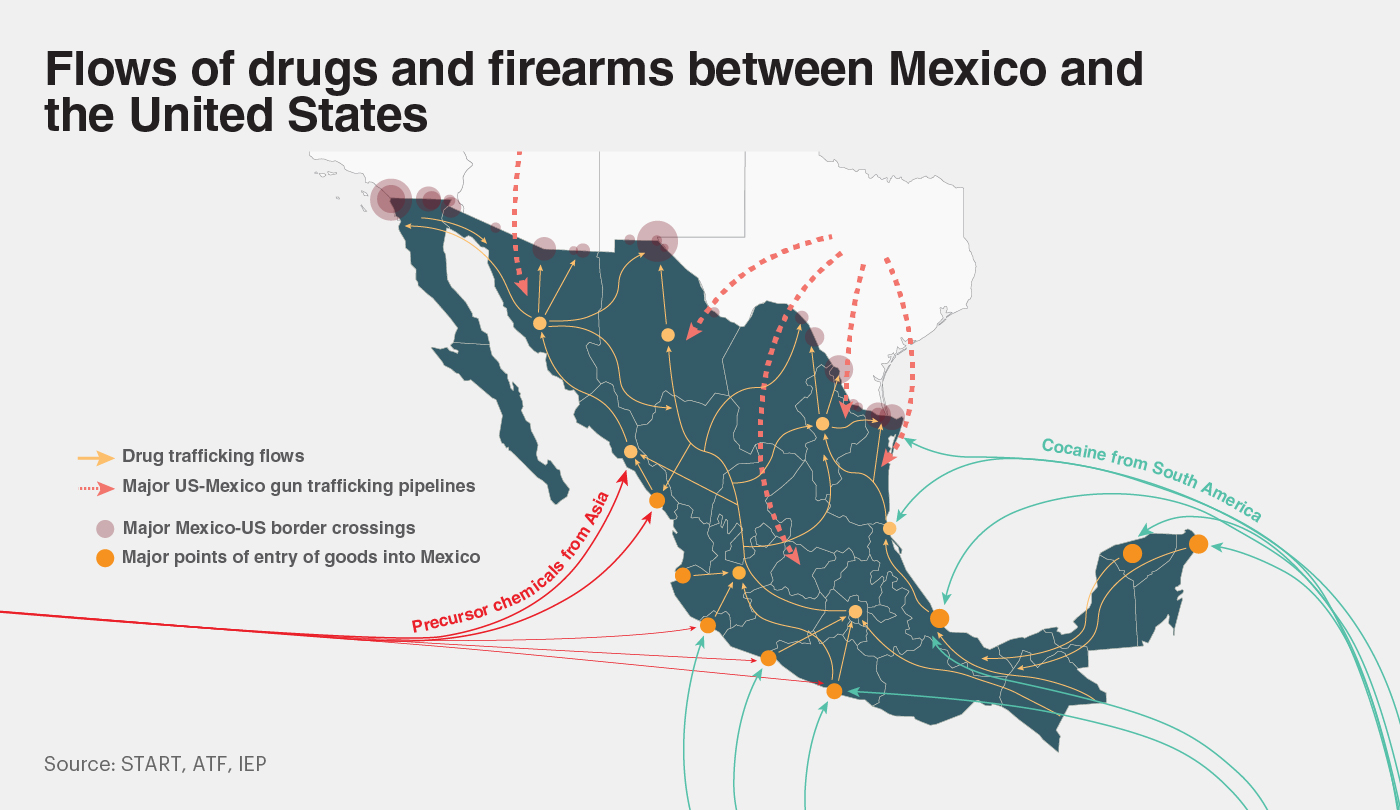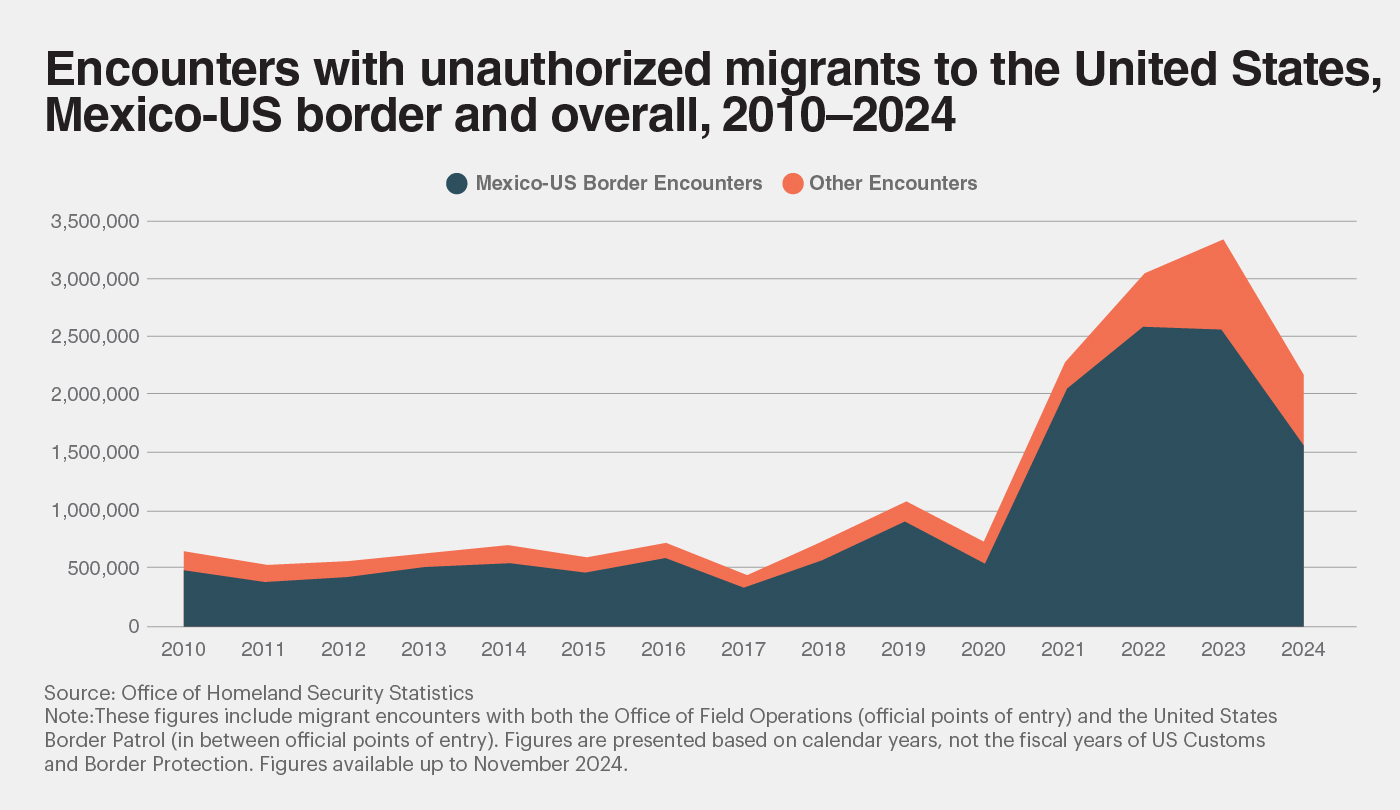In this year’s edition of the Mexico Peace Index 2025, we examine the country’s 3,000-kilometre border with the United States, a site of countless two-way flows of goods and people. While the vast majority of these flows are legal, regulated, and mutually beneficial, certain illicit and unauthorised movements have resulted in instability and social harm in both countries. Some of the primary routes of the two most devastating flows, drugs and firearms, are depicted in the following map. In Mexico, these illegal flows have fuelled extreme levels of armed conflict among organised criminal groups across large swaths of the country, and in the US they have been associated with tens of thousands of deaths from drug overdoses.

In the past decade, shifts in the US drug market have led to significant changes in Mexico’s drug trafficking organisations. Namely, there has been a significant decrease in demand for plant-based drugs, like marijuana and heroin, while demand for synthetic drugs, particularly fentanyl, has surged. Given fentanyl’s low production costs, this shift has been highly lucrative for drug cartels.
Despite the overall strength and profitability of the fentanyl trade, recent data suggests that fentanyl trafficking across the Mexico-US border may have peaked and could now be on the decline. Between 2019 and 2023, the amount of fentanyl seized at the Mexico-US border increased by more than 600 percent, rising from 604 to 4,267 kilograms. But in 2024, there was a 19.3 percent decline in the total volume seized. Moreover, in 2024, fentanyl-related overdose deaths in the US declined for the first time, following substantial increases over the past decade.
Data suggests that most people that traffic fentanyl across the Mexico-US border are US citizens. Between 2019 and 2024, US citizens represented 80 per cent of those caught with the drug during border crossings at official points of entry.
Moreover, US citizens have been instrumental in supporting the illicit movement of firearms from the US to Mexico, a flow which has been referred to as the “iron river”. In many cases, gun smugglers enlist US residents or citizens to purchase firearms from gun shops or gun shows and then transfer them to a cartel representative.
Traces performed on guns recovered at Mexican crime scenes have consistently shown that at least two-thirds are smuggled into the country from the US. As shown by the above map, about three-quarters of those guns originate in US southwest border states, particularly Arizona and Texas, where they are brought into Mexico via trafficking pipelines to Sonora, Chihuahua, Nuevo León, Tamaulipas and Guanajuato.
These pipelines have increasingly armed organised criminal groups, including with military-grade firearms, in their highly lethal territorial disputes with each other and with government security forces. In addition to conflict over control of drug trafficking routes, organised crime groups have engaged in territorial disputes for control of other illicit rackets, including human smuggling, resulting in an increase in conflict in the US..
Human smuggling operations, which are often affiliated with large criminal organisations, have become an increasingly lucrative business. Recent reports suggest that migrants seeking to cross the Mexico-US border can be charged between US$7,000 and US$18,000 to be smuggled, and that cartels may be generating a combined revenue of between US$4 billion and US$12 billion dollars a year from such operations.
It is not known what proportion of migrants employ smugglers to help them enter the US. However, as with the flows of certain illicit goods across the border, there have been surges in the unauthorised flows of migrants in recent years, and these have also given rise to an array of social challenges in the US and Mexico.
Nevertheless, these migrant flows also seem to have peaked and are now on a downward trajectory. As shown in the following figure, between 2010 and 2018, US Customs and Border Control consistently recorded fewer than 600,000 encounters with unauthorised migrants attempting to cross the Mexico-US border. Beginning in 2019, however, the number began to rise. Then, with the worldwide declines in international movement associated with the onset of COVID-19, there was a temporary drop in encounters in 2020. But in 2021, the number again increased dramatically. The number of encounters eventually peaked in 2022 and 2023 at over 2.5 million each year, before dropping by more than a third in 2024, to around 1.6 million.

The rise in migrant border encounters between 2021 and 2023 has been ascribed to several factors. The COVID-19 pandemic resulted in economic hardship and increased social instability in many countries. Once restrictions on movement began to ease, many people in regions facing violence and poverty sought better opportunities in the US. This was evident through the growing number of migrants from politically unstable countries in South America, who historically did not tend to seek entry into the US through its southern border. In addition, certain policy and rhetorical shifts under the Biden administration created the perception of more accessible asylum procedures, which led many more people to attempt to cross the border. Some have also attributed the surge in encounters to be in part the result of changing migrant behaviours in response to the significant backlog in US asylum claims. A prolonged process may have incentivised migrants to intentionally present themselves to border authorities in order to claim asylum, rather than aiming to cross stealthily, further inflating encounter statistics.
Whether authorised or unauthorised, whether licit or illicit, the flows of goods and people across the Mexico-US border have historically had, and will continue to have, significant impacts on the stability of both countries. While recent evidence suggests that certain unlawful flows may be on the decline, it remains to be seen whether these trends will be sustained. Bilateral collaboration to support the continued decline of unlawful flows, combined with the bolstering of those that are legal and mutually beneficial, will be crucial to the economic and social wellbeing of Mexico and the United States in the coming years.